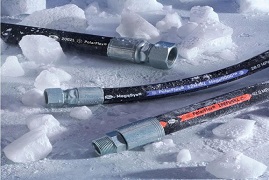How to protect hydraulics in cold temperatures
As winter approaches (yes, how did that happen!), you may be thinking of how to protect your hydraulics, in our latest blog, we’re looking at how cold temperatures can affect your hydraulic systems and how you can prevent problems or downtime. Cold and freezing weather can cause problems in your hydraulic systems if they are…
As winter approaches (yes, how did that happen!), you may be thinking of how to protect your hydraulics, in our latest blog, we’re looking at how cold temperatures can affect your hydraulic systems and how you can prevent problems or downtime.
Cold and freezing weather can cause problems in your hydraulic systems if they are not adequately prepared. When hydraulic equipment is exposed to cold temperatures, rubber components such as seals, fittings, mounts, and hoses can be seriously damaged during operation.
Here are three tips to keep your hydraulic machinery running smoothly even during the frigid winter months.
- Check Fluids
You are not checking the levels, but rather checking the viscosity: if the fluid is too thick to drip off the end of the dipstick, it is too viscous to function properly. Trying to run your system in that condition will seriously damage it. This increase in viscosity is also why it is important to give your hydraulic equipment a chance to warm up before use. Start up the equipment and let it idle in order to warm up the hydraulic system and the fluids that it depends on before you put the equipment to work.
- Allow time to warm up
Like the human body, hydraulics also need time to warm up before being put through heavy paces. If you run the equipment cold without any warm up time, you can damage the system. This can lead to costly repairs. Instead, warm up the hydraulic system before operating any of the equipment attachments. It’s also wise to half throttle the engine and engage attachments for 10 to 15 seconds before going full steam ahead.
- Check Rubber Components Regularly
Cold temperatures can wreak havoc on rubber components. That is why it is essential to check your rubber hydraulic components for tears or cracks before you start to operate the equipment. It is also wise to have spare rubber hoses, seals, mounts and fittings on hand if you are going to be operating in frigid temperatures.
Need assistance with your hydraulic systems? Contact our technical team on hos@hos.co.uk, we’re here to help.


